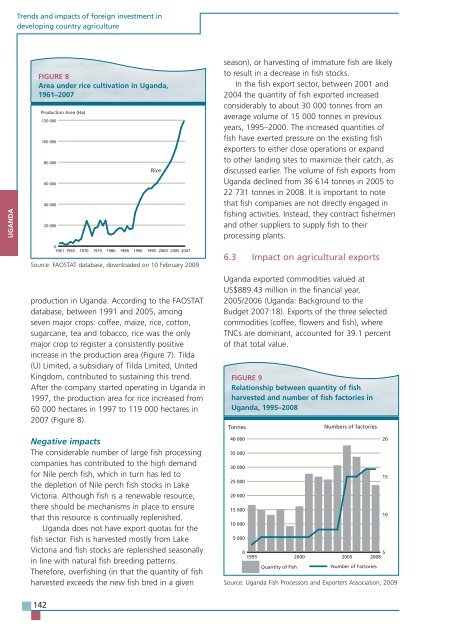TRENDS AND IMPACTS OF FOREIGN INVESTMENT IN DEVELOPING COUNTRY AGRICULTURE
TRENDS AND IMPACTS OF FOREIGN INVESTMENT IN DEVELOPING COUNTRY AGRICULTURE
TRENDS AND IMPACTS OF FOREIGN INVESTMENT IN DEVELOPING COUNTRY AGRICULTURE
You also want an ePaper? Increase the reach of your titles
YUMPU automatically turns print PDFs into web optimized ePapers that Google loves.
UG<strong>AND</strong>A<br />
Trends and impacts of foreign investment in<br />
developing country agriculture<br />
FIGURE 8<br />
Area under rice cultivation in Uganda,<br />
1961–2007<br />
production in Uganda. According to the FAOSTAT<br />
database, between 1991 and 2005, among<br />
seven major crops: coffee, maize, rice, cotton,<br />
sugarcane, tea and tobacco, rice was the only<br />
major crop to register a consistently positive<br />
increase in the production area (Figure 7). Tilda<br />
(U) Limited, a subsidiary of Tilda Limited, United<br />
Kingdom, contributed to sustaining this trend.<br />
After the company started operating in Uganda in<br />
1997, the production area for rice increased from<br />
60 000 hectares in 1997 to 119 000 hectares in<br />
2007 (Figure 8).<br />
Negative impacts<br />
The considerable number of large fish processing<br />
companies has contributed to the high demand<br />
for Nile perch fish, which in turn has led to<br />
the depletion of Nile perch fish stocks in Lake<br />
Victoria. Although fish is a renewable resource,<br />
there should be mechanisms in place to ensure<br />
that this resource is continually replenished.<br />
Uganda does not have export quotas for the<br />
fish sector. Fish is harvested mostly from Lake<br />
Victoria and fish stocks are replenished seasonally<br />
in line with natural fish breeding patterns.<br />
Therefore, overfishing (in that the quantity of fish<br />
harvested exceeds the new fish bred in a given<br />
142<br />
Production Area (Ha)<br />
120 000<br />
100 000<br />
80 000<br />
60 000<br />
40 000<br />
20 000<br />
0<br />
1961 1965 1970<br />
1975<br />
1980<br />
1985<br />
1990<br />
Rice<br />
1995 2000 2005 2007<br />
Source: FAOSTAT database, downloaded on 10 February 2009<br />
season), or harvesting of immature fish are likely<br />
to result in a decrease in fish stocks.<br />
In the fish export sector, between 2001 and<br />
2004 the quantity of fish exported increased<br />
considerably to about 30 000 tonnes from an<br />
average volume of 15 000 tonnes in previous<br />
years, 1995–2000. The increased quantities of<br />
fish have exerted pressure on the existing fish<br />
exporters to either close operations or expand<br />
to other landing sites to maximize their catch, as<br />
discussed earlier. The volume of fish exports from<br />
Uganda declined from 36 614 tonnes in 2005 to<br />
22 731 tonnes in 2008. It is important to note<br />
that fish companies are not directly engaged in<br />
fishing activities. Instead, they contract fishermen<br />
and other suppliers to supply fish to their<br />
processing plants.<br />
6.3 Impact on agricultural exports<br />
Uganda exported commodities valued at<br />
US$889.43 million in the financial year,<br />
2005/2006 (Uganda: Background to the<br />
Budget 2007:18). Exports of the three selected<br />
commodities (coffee, flowers and fish), where<br />
TNCs are dominant, accounted for 39.1 percent<br />
of that total value.<br />
FIGURE 9<br />
Relationship between quantity of fish<br />
harvested and number of fish factories in<br />
Uganda, 1995–2008<br />
Tonnes Numbers of factories<br />
40 000<br />
35 000<br />
30 000<br />
25 000<br />
20 000<br />
15 000<br />
10 000<br />
5 000<br />
0<br />
1995<br />
Quantity of Fish<br />
2000<br />
2005<br />
Number of Factories<br />
5<br />
2008<br />
Source: Uganda Fish Processors and Exporters Association, 2009<br />
20<br />
15<br />
10


